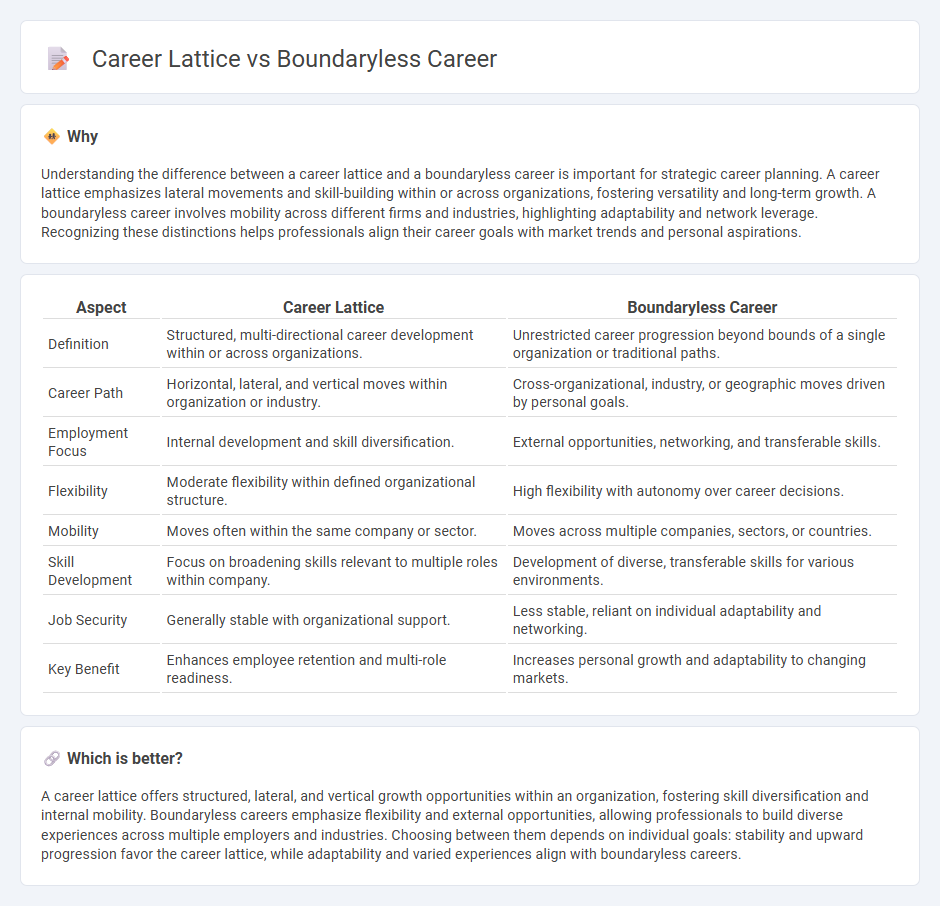
A career lattice emphasizes lateral and diagonal moves within or across organizations to build diverse skills and experiences, while a boundaryless career transcends traditional organizational limits, focusing on individual mobility and adaptability across multiple employers and industries. Employment trends increasingly favor boundaryless careers due to evolving job markets and technological advancements, highlighting the importance of personal branding and network cultivation. Explore how these career models can shape your professional growth and opportunities.
Why it is important
Understanding the difference between a career lattice and a boundaryless career is important for strategic career planning. A career lattice emphasizes lateral movements and skill-building within or across organizations, fostering versatility and long-term growth. A boundaryless career involves mobility across different firms and industries, highlighting adaptability and network leverage. Recognizing these distinctions helps professionals align their career goals with market trends and personal aspirations.
Comparison Table
| Aspect | Career Lattice | Boundaryless Career |
|---|---|---|
| Definition | Structured, multi-directional career development within or across organizations. | Unrestricted career progression beyond bounds of a single organization or traditional paths. |
| Career Path | Horizontal, lateral, and vertical moves within organization or industry. | Cross-organizational, industry, or geographic moves driven by personal goals. |
| Employment Focus | Internal development and skill diversification. | External opportunities, networking, and transferable skills. |
| Flexibility | Moderate flexibility within defined organizational structure. | High flexibility with autonomy over career decisions. |
| Mobility | Moves often within the same company or sector. | Moves across multiple companies, sectors, or countries. |
| Skill Development | Focus on broadening skills relevant to multiple roles within company. | Development of diverse, transferable skills for various environments. |
| Job Security | Generally stable with organizational support. | Less stable, reliant on individual adaptability and networking. |
| Key Benefit | Enhances employee retention and multi-role readiness. | Increases personal growth and adaptability to changing markets. |
Which is better?
A career lattice offers structured, lateral, and vertical growth opportunities within an organization, fostering skill diversification and internal mobility. Boundaryless careers emphasize flexibility and external opportunities, allowing professionals to build diverse experiences across multiple employers and industries. Choosing between them depends on individual goals: stability and upward progression favor the career lattice, while adaptability and varied experiences align with boundaryless careers.
Connection
Career lattice and boundaryless career concepts connect by emphasizing flexible, non-linear career progression. Both focus on skill development, adaptability, and mobility across roles and organizations rather than traditional hierarchical advancement. This approach enhances employability and supports continuous career growth in dynamic job markets.
Key Terms
Mobility
Boundaryless careers emphasize physical and psychological mobility across organizations and industries, enabling professionals to seek diverse opportunities beyond traditional corporate ladders. In contrast, career lattices prioritize lateral moves within or across departments to build varied skills and experiences while maintaining organizational ties. Explore the nuances of mobility in career planning to unlock personalized growth pathways.
Flexibility
Boundaryless careers emphasize flexibility by allowing individuals to move across different organizations and industries without traditional hierarchical constraints, enhancing diverse skill acquisition. Career lattices promote lateral and diagonal movements within or across organizations, offering flexible pathways that prioritize skill development and work-life balance. Explore more about how these models redefine professional growth and adaptability in today's dynamic job market.
Advancement Paths
Boundaryless careers emphasize fluid movement across organizations and roles without traditional hierarchical constraints, promoting diverse skill acquisition and networking. Career lattices prioritize lateral moves and diagonal shifts within a company, allowing employees to build a broad skill set while gradually advancing their position. Explore more to understand which advancement path aligns best with your professional goals.
Source and External Links
Boundaryless Career - A boundaryless career means individuals are not limited to one employer, job, organization, or field; it emphasizes self-motivation, adaptability, and continuous skills development as individuals manage their own career progression within a flexible work environment.
The boundaryless career - This concept describes careers crossing organizational boundaries physically or psychologically, focusing on employability and marketability of skills beyond loyalty to one employer amidst increasingly transactional and insecure employment relationships.
Boundaryless Careers - A boundaryless career involves high job mobility used to pursue growth and personal goals, not requiring an individual to change employers but emphasizing career paths unconstrained by traditional organizational boundaries.
 dowidth.com
dowidth.com